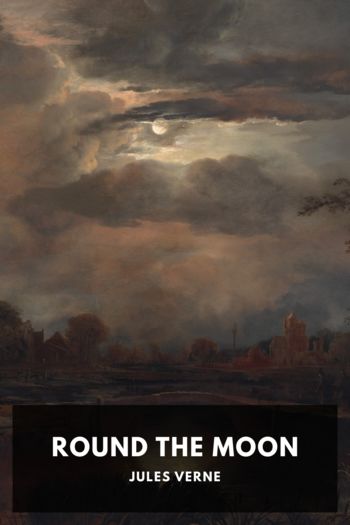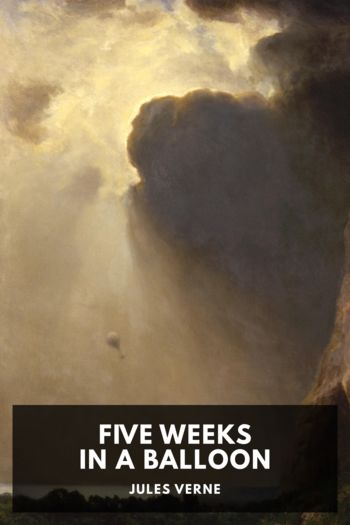From the Earth to the Moon, Jules Verne [beach books .TXT] 📗

- Author: Jules Verne
Book online «From the Earth to the Moon, Jules Verne [beach books .TXT] 📗». Author Jules Verne
On the 20th of October of the preceding year, after the subscription list was closed, the president of the Gun Club had credited the Cambridge Observatory with the sums necessary for the construction of a vast optical instrument. This telescope was to be powerful enough to render visible on the surface of the moon an object being at least nine feet wide.
There is an important difference between a field-glass and a telescope, which it is well to recall here. A field-glass is composed of a tube which carries at its upper extremity a convex glass called an object-glass, and at its lower extremity a second glass called ocular, to which the eye of the observer is applied. The rays from the luminous object traverse the first glass, and by refraction form an image upside down at its focus. This image is looked at with the ocular, which magnifies it. The tube of the field-glass is, therefore, closed at each extremity by the object and the ocular glasses.
The telescope, on the contrary, is open at its upper extremity. The rays from the object observed penetrate freely into it, and strike a concave metallic mirror—that is to say, they are focused. From thence their reflected rays meet with a little mirror, which sends them back to the ocular in such a way as to magnify the image produced.
Thus in field-glasses refraction plays the principal part, and reflection does in the telescope. Hence the name of refractors given to the former, and reflectors given to the latter. All the difficulty in the execution of these optical instruments lies in the making of the object-glass, whether they be made of glass or metallic mirrors.
Still at the epoch when the Gun Club made its great experiment these instruments were singularly perfected and gave magnificent results. The time was far distant when Galileo observed the stars with his poor glass, which magnified seven times at the most. Since the 16th century optical instruments had widened and lengthened in considerable proportions, and they allowed the stellar spaces to be gauged to a depth unknown before. Amongst the refracting instruments at work at that period were the glass of the Poulkowa Observatory in Russia, the object-glass of which measured 15 inches in width, that of the French optician Lerebours, furnished with an object-glass equally large, and lastly that of the Cambridge Observatory, furnished with an object-glass 19 inches in diameter.
Amongst telescopes, two were known of remarkable power and gigantic dimensions. The first, constructed by Herschel, was 36 feet in length, and had an object-glass of 4 feet 6 inches; it magnified 6,000 times; the second, raised in Ireland, at Birrcastle, in Parsonstown Park, belonged to Lord Rosse; the length of its tube was 48 feet and the width of its mirror 6 feet; it magnified 6,400 times, and it had required an immense erection of masonry on which to place the apparatus necessary for working the instrument, which weighed 12½ tons.
But it will be seen that notwithstanding these colossal dimensions the magnifying power obtained did not exceed 6,000 times in round numbers; now that power would only bring the moon within 39 miles, and would only allow objects 60 feet in diameter to be perceived unless these objects were very elongated.
Now in space they had to deal with a projectile 9 feet wide and 15 long, so the moon had to be brought within five miles at least, and for that a magnifying power of 48,000 times was necessary.
Such was the problem propounded to the Cambridge Observatory. They were not to be stopped by financial difficulties, so there only remained material difficulties.
First of all they had to choose between telescopes and field-glasses. The latter had some advantages. With equal object-glasses they have a greater magnifying power, because the luminous rays that traverse the glasses lose less by absorption than the reflection on the metallic mirror of telescopes; but the thickness that can be given to glass is limited, for too thick it does not allow the luminous rays to pass. Besides, the construction of these vast glasses is excessively difficult, and demands a considerable time, measured by years.
Therefore, although images are better given by glasses, an inappreciable advantage when the question is to observe the moon, the light of which is simply reflected they decided to employ the telescope, which is prompter in execution and is capable of a greater magnifying power; only as the luminous rays lose much of their intensity by traversing the atmosphere, the Gun Club resolved to set up the instrument on one of the highest mountains of the Union, which would diminish the depth of the aerial strata.
In telescopes it has been seen that the glass placed at the observer’s eye produces the magnifying power, and the object-glass which bears this power the best is the one that has the largest diameter and the greatest focal distance. In order to magnify 48,000 times it must be much larger than those of Herschel and Lord Rosse. There lay the difficulty, for the casting of these mirrors is a very delicate operation.
Happily, some years before a savant of the Institut de France, Léon Foucault, had just invented means by which the polishing of object-glasses became very prompt and easy by replacing the metallic mirror by taking a piece of glass the size required and plating it.
It was to be fixed according to the method invented by Herschel for telescopes. In the great instrument of the astronomer at Slough, the image of objects reflected by the mirror inclined at the bottom of the tube was formed at the other extremity where the eyeglass was placed. Thus the observer, instead of being placed at the lower end of the tube, was hoisted to the upper end, and there with his eyeglass he looked down into the enormous cylinder. This combination had the advantage of doing away with the little mirror destined to send back the image to the ocular glass, which





Comments (0)